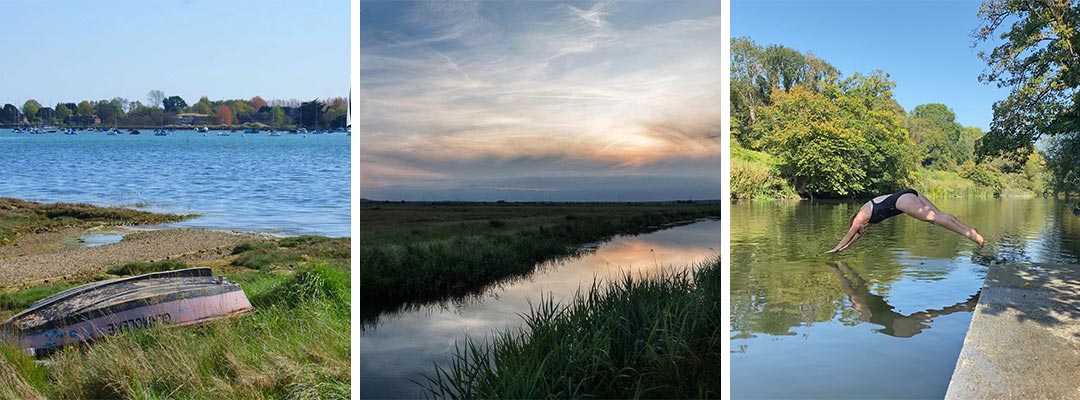So much more than swimming: Kitty Dimbleby explains the benefits of wild swimming and lists the top places to take the plunge in Sussex
In February, when temperatures dropped to freezing, I grabbed my swimsuit and headed to a small lake a few miles from my house. Taking deep breaths, I waded in, breaking the ice with my bare hands until I was deep enough to dunk in the water up to my neck. Utterly euphoric at the mad joy of it all. It was one of 55 ‘wild’ (so called because they are not in a swimming pools) swims, or dips, I managed this autumn and winter.
As a child I loved swimming outdoors in any water and in any weather so, when I turned forty at the start of 2020 (and with various trips planned abroad to celebrate) I decided I would swim in as many ‘wild’ spots as possible to mark my milestone birthday. Of course, Covid put a stop to most travel but, keeping in line with restrictions, I’ve still managed to swim in a range of UK rivers and various coastal spots. I’m hooked and even when the pools reopen, I will continue to swim outdoors, in the ‘wild’ from now on. And I’m not alone – last year saw a reported 323% rise in people ‘wild swimming’. So, what’s the draw?
In the wild swimming community, I am what they would call a ‘dipper’ – I do it for the rush of endorphins rather than to actually swim properly. I don’t wear a wetsuit because I prefer the feel of the cold water directly on my skin. The buzz lifts my mood and the cold water helps with aches and pains. For safety I always go with someone and, as the temperature drops, so does the amount of time I spend in the water – if the water is four degrees that’s a four-minute dip.
It sounds like a lot of effort for not very long but it’s about the whole experience: from the willpower needed to get into the water (sometimes I really don’t want to, but I’m yet to walk away from a safe chance to swim) to the shock of the cold. Breathing deeply to regulate my heartbeat, feeling my hands and feet go numb, then getting out, laughing at the ridiculousness of it all and then dressing quickly and sipping a flask of hot chocolate to warm up. Being immersed in water and nature, away from real life – however briefly – has kept me sane these past challenging 12 months.
Each swim is a mini adventure, and I can’t wait for warmer days when I will be able to spend longer in the water, travel to beaches and lounge on riverbanks. Sea and river swimming -even in the unreliable British summer – will feel positively tropical after my ice breaking dips!
If you’re thinking about dipping your toes into wild swimming then my top tips for you would be to:
- Never swim alone.
- Never jump into water you have not thoroughly checked for depth or obstructions and always make sure you know how you will get out before you get in.
- Don’t get too cold – warm up with exercise and warm clothes before and after a swim. It’s important to acclimatise, don’t go for your first wild swim in February! Cold showers are a good way to get used to the cold before you take the plunge.
- Make sure you are visible to other water users – wear a coloured swim hat so you can be seen and use a tow float.
- Remember to breathe, for me the biggest benefit has been learning to slow my breathing down while I’m in the water. Having to manage my flight or fight instinct when my body is immersed in the cold helps me actually deal with stress much better in everyday life.
Be aware of the changeable nature of wild swimming spots. What may be a good place to swim at one point in time, may not be suitable the next time you visit, due to changes in water quality, weather or temperature. Assess locations for safe entry and exit points, know your limits, check for obstructions and water depth before entering a wild swim spot. Beware of strong undercurrents and poor water quality. It is recommended that you do not swim on your own

We’ve rounded up the top five wild swimming spots in Sussex:
Tide Mills, East Sussex
Sitting between Newhaven and The Buckle at Seaford, Tide Mills is actually one of the last surviving tidemills in the UK. A very sheltered spot, Tide Mills is an ideal location for wild swimming and provides safe conditions for all abilities.
Litlington, East Sussex
Further inland, the River Cuckmere runs through the village of Litlington near Polegate. This section of the river is tidal and surrounded by grasslands, so it is good for swimming in at high tide.
Sandy Bay, West Sussex
Located just by Cowdray Castle, swimmers can enjoy a picturesque dip in the River Rother. Ideal for beginners and young swimmers, the waters are no more that 5ft deep and there is a gentle incline down the riverbank to gently introduce you to the waters.
Bosham Hoe, West Sussex
In the beautiful stretch of water stretching from Chichester Harbour, swimmers will get to experience a sheltered swim at Bosham Hoe. Lined with plenty of things to see and seabirds surrounding you, you will never tire from a swim here. Please make sure you watch out for marine traffic and ensure you are visible. Early mornings or sunset swims are recommended!
Wallers Haven, East Sussex
Wallers Haven is a slow flowing deep river that can be around 15ft deep in places. Recommended for more advanced wild swimmers, makes sure you visit with someone as it can be difficult to get in and out at some places along the river. A completely secluded spot, with a jetty, perfect for taking the plunge and jumping in!
By Kitty Dimbleby – @kittydimbleby
TYPES OF STAY
T: 07773 783 863
E: Zoe@cabinsandcastles.co.uk
SUBSCRIPTIONS
© Copyright Cabins and Castles LTD 2018 | Company no: 11139319 | Privacy Policy | Terms and Conditions | Website by Ryn Frank

